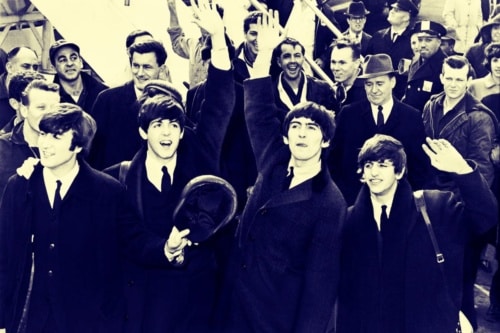By Dr. Craig T. Follins
It is late summer and I am sitting in front of my flat screen anticipating the next event in the summer Olympics in Rio. The studio host begins a discussion about a song that was written some 50 or so years ago about a girl from Ipanema. He talked about this song being among the top ten most played songs of all time. To be sure, I just knew they would tell us what the most played song of all time is. Turns out that the Beatles’ “Yesterday” with over 7 million plays at 380 spins per day on average since it’s 1965 release is thought to be in a dead heat with the Righteous Brothers “You’ve Lost That Lovin’ Feelin’ with about 8 million plays a day on the radio and television (wcbsfm.cbslocal.com)
 You may ask just what does all of this have to do with community colleges? My response is, everything. Noting that it was around the mid-1960s when there was a community college being built somewhere in America nearly every month. This was the height of another period of war called Vietnam where returning soldiers were coming home in search of a good transition into the civilian world. Moreover, this was also a time of great unrest in which civil and human rights were part of the daily lexicon in American life. It was 1965 and the Beatles’ “Yesterday” was played loudly across college campuses and is thought in many circles to be a song for a generation of change. Indeed, we all wanted to believe in a yesterday when troubles seemed so far away.
You may ask just what does all of this have to do with community colleges? My response is, everything. Noting that it was around the mid-1960s when there was a community college being built somewhere in America nearly every month. This was the height of another period of war called Vietnam where returning soldiers were coming home in search of a good transition into the civilian world. Moreover, this was also a time of great unrest in which civil and human rights were part of the daily lexicon in American life. It was 1965 and the Beatles’ “Yesterday” was played loudly across college campuses and is thought in many circles to be a song for a generation of change. Indeed, we all wanted to believe in a yesterday when troubles seemed so far away.
Fast forward to 2016 and we appear to be eerily in a familiar place of social and civil unrest and the need to educate a new generation of returning military veterans seeking to transition to a solid, middle-class life. We are also witnessing many traditional aged students (18-22) having to make significant choices about where to begin or continue their post-secondary education. While quality, academic programming, tradition, athletics, location, family history are all important considerations, the overall cost of a quality education has become a critical factor in the selection of an educational or training institution.
Yesterday (that being 1965) the cost of an average home was about $13,000 (www. thepeoplehistory.com), average income was $6,450, gasoline was about 31 cents a gallon and a brand new car was about $2,650. A loaf of bread was 21 cents and rent was about $118.00. Oh, how we long for “Yesterday”. Today, most students cannot afford the cost of a top-tier university or college. According to Bloomberg News, students attending Ivy League schools such as Brown University will pay nearly $50,000 per year to attend. There are scholarships and other financial assistance, but the cost of education is rising.
While the cost of education is rising, so is the amount of debt that students are incurring. The average amount of debt that students leave college with today is north of $30,000. Thus, while we reminisce about “Yesterday” the reality of today is staring families in the face. Enter the community college. Parents, K-12 stakeholders and educational policy experts are taking a hard look at community colleges. Enrolling nearly half of all undergraduate students and long a ticket to a middle- class wage, these colleges are even attracting college graduates returning for a high-wage skill.
As a society, we are still debating whether students should go with their passion, or enter a career track leading to meaningful employment. This is a conversation that will continue to be a significant aspect of how students transition into a life after education and training. Community colleges have become more introspective in recent years, no longer concerned with just access. They are focused on access and success. There is a greater degree of public demand for accountability and completion. Scarce tax dollars require regular reporting of student outcomes. Therefore, reports related to enrollment, course completion, persistence, retention and completion are cornerstone elements of community college organizations. There may be a community college in your future.
Community colleges are at the forefront of new ways of learning such as the Pathways Initiative by the American Association of Community Colleges. Thirty colleges are part of a cohort focused on providing a very clear sequence of courses along with support services designed to accelerate completion. Pathways are not new, but the focus on the development of a clear path to completion for all students is a significant new development. The research for the student pathways was conducted by The Community College Research Center (CCRC), which is housed at Columbia University in New York. In fact, many community colleges are now utilizing a new book entitled: Redesigning America’s Community Colleges: A Clearer Path to Student Success as a guide to successful student pathway development.
Having worked in various leadership roles in community colleges across the country (including college president at two), I can tell you first-hand that community colleges are part of the future of many K-12 students and their families. In addition to great academics and convenience, community colleges offer adult education, continuing education, citizenship, community education and extended learning opportunities. Community colleges offer smaller classes at less cost and nurturing environments filled with stakeholders interested in the success of every student that walks through the door in search of a better life. Community college students often talk about that “lovin” feeling they get when they are provided with all of the wrap around services they receive.
Community colleges seek to meet the specific needs of the communities they serve. Many high school students, in fact, return to take classes in community colleges during summer and holiday breaks. This saves on costs and helps accelerate learning. Students are met where they are and moved forward. No other educational entity has the history, resources and organizational structure of a community college. The idea of the community is so unique that it is being developed overseas as well.
As I watched the Olympics and thought about “Yesterday,” I recalled my own experience as a community college student in the 1970s. I returned home from the Army and was not able to get into a four-year college because of my grades. However, New York City Community College was in my future. While I did not earn my degree there, I was able to use the credits I earned and later transferred to a four-year institution (where I later graduated). As a community college leader, I take the time to talk to students and parents about my “Yesterday” and that perhaps, community colleges may be in their own futures.
Yesterday, today and tomorrow we are challenged with a changing society with new demographics, limited resources, high expectations, increased demand for higher skills and a need to close class and wage gaps. There may be a community college that is part of a future that is filled with choices that are often confusing. What is not confusing is knowing that nearly 65 percent of all future jobs/careers will require some form of higher education. Many of these jobs are “middle-skill” jobs requiring more than a high school diploma, but not necessarily a four-year degree. I encourage all students to have a credential beyond high school that affords them an opportunity to be a globally informed, contributing member of this wonderful world. Perhaps a community college is a part of that equation.
Dr. Craig T. Follins is an experienced senior community college leader and is a distinguished graduate of the Community College Leadership Program at The University of Texas at Austin | Cfollins@gmail.com | Twitter







